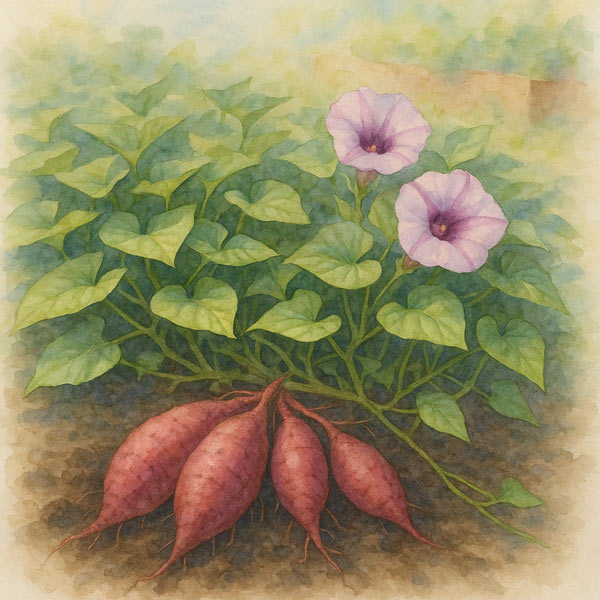 When it comes to growing sweet potatoes in Central Florida, the internet is full of advice—some of it helpful, some of it… not so much. Whether you’re dreaming of a lush patch of leafy vines or wondering if it’s too hot (or too late!) to start planting, let’s clear up a few common sweet potato myths and explore how just one order can turn into years of delicious, homegrown bounty.
When it comes to growing sweet potatoes in Central Florida, the internet is full of advice—some of it helpful, some of it… not so much. Whether you’re dreaming of a lush patch of leafy vines or wondering if it’s too hot (or too late!) to start planting, let’s clear up a few common sweet potato myths and explore how just one order can turn into years of delicious, homegrown bounty.
My Sweet Potato Story
My first year growing sweet potatoes, I ordered a single pound of slips from a farm in southern Georgia. Back then, I thought this was the only way to plant sweet potatoes. I planted them in early May, and they absolutely thrived in the Florida heat—sending vines in every direction by midsummer.
When harvest time came, I thought I’d dug them all up. But the following spring, a surprise: new vines pushing up from deep in the raised bed, blooming on their own. The sweet potatoes had overwintered underground and were back for round two.
Last year, I harvested more than ever—and tucked a dozen small ones into my pantry. Before I knew it, they had grown roots. I popped them into the soil at the beginning of May, and now, once again, they’ve taken over my garden in all the best ways. Their dense, heart-shaped leaves are beautiful, edible, and practical—shading the soil and keeping it cool through the hottest months.
Even better? If I need to reorganize a garden bed, I can gently dig up a sweet potato, move it to a new raised bed, and it doesn’t miss a beat. From a single order of one-pound slips, I’m now continuously growing and harvesting sweet potatoes every season—without spending another dime.
Myth #1: You need to buy new slips every year.
Truth: One slip order can feed your garden for years to come.
With the right care, your sweet potato patch can become self-sustaining. You can replant small tubers that sprout in storage, take slips from your own crop, or even divide and relocate vines with rooted nodes.
Can You Grow Sweet Potatoes from a Grocery Store Tuber?
Yes—with a few caveats.
Make sure to buy organic sweet potatoes. Conventional grocery store varieties are often treated with a sprout inhibitor to extend shelf life and may not root well.
Here’s how to grow your own slips at home:
DIY Sweet Potato Slip Method
-
Choose a healthy organic sweet potato.
-
Cut it in half (optional) and suspend it in a jar of water using toothpicks. Half submerged, half out.
-
Place it in a warm, sunny windowsill. After 2–3 weeks, you’ll see sprouts (slips) emerging.
-
When the slips are 4–6 inches long, twist them off the tuber and place them in a new glass of water to grow roots.
-
Once the roots are about an inch long, plant them in the soil and water deeply.
You can also bury the whole potato sideways in moist soil and wait for it to sprout.
Extend Your Harvest: Tips for Long-Term Sweet Potato Success
Let a few tubers overwinter in your garden. In Central Florida, they often survive and regrow in spring.
Store small potatoes in your pantry, let them sprout, and replant.
Replant vine cuttings from established plants in new beds. Just snip a piece with rooted nodes, and place it in the soil.
Grow slips from your own harvest each year to avoid buying more.
Why I Keep Growing Sweet Potatoes
They’re beautiful. They’re bountiful. And they’re one of the few crops that absolutely love our hot, humid summers. The vines help shade and cool the soil. The leaves are edible and nutritious. And once you have them, you might never need to buy slips again.
Ready to start your own patch? It begins with one sweet potato. Trust me—I’ve grown enough to know: the myths don’t hold a candle to the magic.
Wait… Is It Really a Vegetable?
Sweet potatoes are considered a vegetable—specifically, a starchy root vegetable. But here’s where it gets interesting:
Botanically, sweet potatoes (Ipomoea batatas) are actually the storage root of a vine in the morning glory family.
Nutritionally, they’re classified as a starchy vegetable, like potatoes, corn, or winter squash.
Culinarily, they’re used as a vegetable in both savory and sweet dishes.
Also worth noting:
Sweet potatoes are not the same as yams, which come from a completely different plant family.
And although we often call them “potatoes,” sweet potatoes aren’t closely related to white potatoes (Solanum tuberosum), which are in the nightshade family.
So in short:
Yes, they’re a vegetable.
But they’re a sweet, starchy, storage-root kind of vegetable—perfect for Florida gardens!
